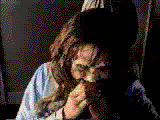| "Personally, Veda's convinced me that alligator's have the right idea. They eat their young." |
| --Eve Arden in Mildred Pierce (1949). |
Monstrous little women, mad moppets, deadly dollies, deranged daughters, sinister sisters--call them what you will, there is no doubt that multifarious images of the evil girl-child haunt the celluloid corridors of popular cinema. A far cry from her innocent sisters, the monstrous little woman is capable of truly shocking crimes. Images of evil children, circulated in posters and film books, are predominantly of feminine furies: Regan, from The Exorcist, murdering clerics, spewing green bile and rotating her head full circle on her neck; Carrie, an avenging monster, drenched in pig's blood, burning up the entire school; and Lolita, the child-woman, sunning herself in her bikini, supremely indifferent, yet fully aware of her devastating effect on the wretched professor.

|
|
Baby Bitches Introduction 1.1 MB quicktime movie |
Little boy monsters (I am thinking of children not yet in their teens), also populate the horror film. Boys are aligned with the spiritual (The Innocents), possessed by the devil (The Omen), and transformed into killers (Pet Semetary), but, in general, their monstrousness is not defined in terms of an abrogation of proper gender roles. Males do become monster at puberty (Twitchell), but their transformations into rough beasts (I Was A Teenage Werewolf, I Was A Teenage Frankenstein), are perfectly in keeping with the male role of sexual predator. Nor is the male body put on display in relation to such things as sexual exhibitionism, dirt, urination, shrieking or masturbation.
If classic mainstream cinema objectifies woman's body to appeal to a voyeuristic gaze, the horror film similarly fetishises the female body, but as an object of disgust, appealing to the shocked, perverse look. A crucial feature of all these films, is the role played by Innocence in the representation of the monstrous little woman.